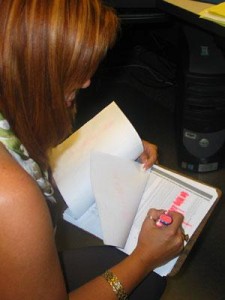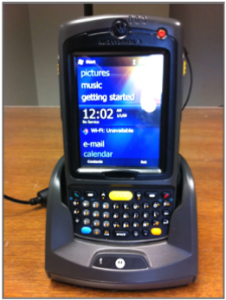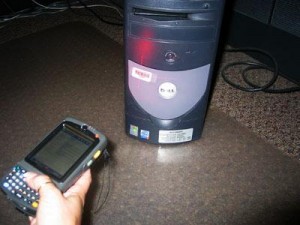An audit of a department’s property inventory can be a lengthy and sometimes frustrating process. Property auditors from the Office of Procurement Services arrive at the department, clipboards in hand, ready to search offices, closets, file cabinets, and other areas in an effort to locate all of the assets on their lists. Once an asset is identified, it is marked off of the list and any notes regarding the asset, such as a change to the room where the asset is located, are written in the margins of the list so they can be manually entered into SAP at the end of the day. This manual, paper-based process is error prone, tedious, and often very time consuming. “There is tremendous opportunity for error when dealing with such a large number of assets and the individual updates required for each asset,” says Patti Mooney, Supervisor, Materials Handling Division with the Office of Procurement Services.
These time consuming audits have become a thing of the past with the launch of Mobile Asset Management, a mobile-based solution for conducting equipment audits developed by the Office of Information Technology (IT) in partnership with the Office of Procurement Services.
The Concept
Procurement Services has expressed an interest in moving to a mobile-based solution for conducting property audits for some time. The basic idea was to implement a solution which would allow the property auditor to scan the bar code label attached to each asset and then update the asset master data within the SAP ERP system, resulting in a more efficient and accurate audit process.
A mobile-based solution for asset management provided a good opportunity for continued development of mobility applications for the University. Mobility is one of the most rapidly changing areas of technology, and research of the current product offerings was needed to make the best long-term decision for the University.
In the end, two distinct approaches emerged for a mobile solution. The first, and by far the more expensive solution, was to purchase commercial software that would integrate with the University’s SAP ERP system. The second and more intriguing solution was to identify a hand-held device/development platform that would meet the needs of the project, and then attempt to develop a native application on the device that would communicate with the SAP system using Web services. Based on knowledge gained from IT staff members attending the 2010 SAP TechED conference, the decision was made to purchase one hand-held device and develop a prototype application in-house. If the prototype application was successful, it would be enhanced into a production version and additional hand-held devices would be purchased for use by Procurement Services.
Selecting a Mobile Platform
One of the critical success factors for this project was selecting a mobile device that would meet the needs of the property auditors in terms of functionality and ruggedness. Several manufacturers, including Motorola, Honeywell, and Intermec were evaluated on factors such as the type of bar code reader, Wi-Fi capability, RFID capability, operating system/development environment, on-device storage capacity, and cost. In the end, the Motorola MC75A hand-held computer emerged as the overall leader of the group and was selected as the hand-held device for this project.
The Motorola MC75A uses Windows Mobile 6 as its operating system, and Motorola provides an Enterprise Mobility Developer Kit (EMDK) for the Microsoft .NET development platform. This kit provides class libraries that allow developers to programmatically access the device’s built-in features, such as the bar code scanner, the camera, and others. This EMDK was used in conjunction with the Microsoft .NET Compact Framework and Microsoft Visual Studio 2008 for the development of the Mobile Asset Management application.
The prototype addressed key features of the application such as the functionality of the bar code scanner, the development of the native application for the device and how the application is distributed to the device, and the use of a Web service for communication between the device and the SAP ERP system. Additional challenges that were faced during the prototype were the ability of the device to communicate using standard Web services, the overall performance of the application without a middleware layer, and the learning curve involved with a new development environment.
At the time the decision was made, Pooja Saxena, Systems Analyst III was nearing the completion of her degree requirements for the Master of Science degree in Computer Science. One of the requirements was the completion of a technical/programming project, and the proof of concept/prototype project for mobile asset management satisfied this requirement.
“I am really glad that I was given the opportunity to take on this project,” said Saxena. “With SAP as our ERP system, we tend to work exclusively with SAP and SAP-related technologies, and diving into the deep waters of the Microsoft development environment was a tough challenge for me. The journey itself had its ups and downs. There were sometimes hours or rather days of struggle in trying to figure out the technology idiosyncrasies, but there were also many moments of success. This project opened a new magical world of mobility development with endless possibilities.”
From Paper to Portable
Using Mobile Asset Management, property auditors can now conduct their audits using a totally electronic, paperless system. Prior to visiting a department, the auditor can select the all of the assets for a department and download the data to the Motorola MC75A. The application has several built-in filters which allow the auditor to filter assets by department, location, the date of the last audit, and the book value of the asset. “The mobile process is a huge plus,” says Mooney, “because it saves time.”
As the property auditors visit the department, they will locate and scan each asset. Upon scanning the barcode, the MC75A retrieves key data from the local database on the device and the auditor can validate and correct this data, if needed. Examples include the description, the personnel number of the employee responsible for this asset, the building/room, and any notes associated with the asset. The application also keeps a running total of the number of assets scanned/remaining, so the auditor knows the status of the current audit at a quick glance.
At anytime during the audit process, the auditor can upload the scanned assets to SAP, provided that wireless network coverage is available. The data transfer is handled using a Web service on SAP’s Process Integration server, which in turn communicates with the SAP ERP system.
The property auditors began using the new system on August 9th, 2011, and they were excited to be using such new technology to carry out their audits. “Mobile Asset Management is a step into the 21st century,” said Mooney. “It is a state of the art scanning system that allows our staff to conduct audits more efficiently, accurately, and timely.”
Rachel Bost, Procurement Manager, shares in the excitement of the rollout of this project. “I’m very excited about Mobile Asset Management and what it means for our property control team. Our auditors no longer have to complete audits with pen and paper and enter inventory items into SAP one record at a time. Now we will be able to complete an audit more accurately and efficiently, which is great for our department as well as the department undergoing the audit.”
Tags: Mobility, SAP

